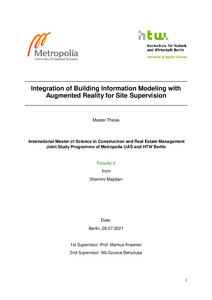Integration of Building Information Modeling with Augmented Reality for Site Supervision
Majidian, Shamim (2021)
Majidian, Shamim
2021
Julkaisun pysyvä osoite on
https://urn.fi/URN:NBN:fi:amk-202301301847
https://urn.fi/URN:NBN:fi:amk-202301301847
Tiivistelmä
The developments in the construction industry have been happening more slowly in comparison with other industries which are partially or fully achieved their goals. This industry is still working to benefit from recent technological advancements in order to control and keep track of, for example; the progression of the Quality and Safety management systems that proceed with the fulfilment of a project.
In the construction industry, the Information and Communication Technologies (ICTs) utilization ratio is comparably limited. Some deficiencies in the construction industry such as incomprehensive road map, ineffective process automation as well as communication breakdown result in poor productivity and extra time, money and energy needed for the implementation of a project. The utilization of Building Information Modelling (BIM) coupled with Augmented Reality (AR) offers opportunities in developing the construction industry. The use of these recent technologies and approaches generates context-specific data about a construction undertaking. Furthermore, it gives you the possibility to examine the performances and advancements of construction operations. Another advantage of applying these technologies is the superimposition of construction projects onto the actual world.
The on-site construction inspection process is cumbersome; it is highly time-taking and requires a large amount of work to extract information from paper or databases. Mobile augmented reality systems provide an effective way to succeed in dealing with the aforementioned problems. By applying such systems better accessibility to the essential data can be attainted and inspection processes can happen more precisely in an easier manner. This can be achieved through faster access to an upgraded visualization of the BIM by the application of augmented reality systems.
Carrying out new approaches and methods in the field of BIM-based AR is challenging. The present study aims at elaborating various notions as well as frameworks used in the performance of construction tasks. Then, it highlights the potential viable measures and procedures that were utilized to overcome the impediments and troubles. Finally, it focuses on the challenges and problems that still exist.
In the construction industry, the Information and Communication Technologies (ICTs) utilization ratio is comparably limited. Some deficiencies in the construction industry such as incomprehensive road map, ineffective process automation as well as communication breakdown result in poor productivity and extra time, money and energy needed for the implementation of a project. The utilization of Building Information Modelling (BIM) coupled with Augmented Reality (AR) offers opportunities in developing the construction industry. The use of these recent technologies and approaches generates context-specific data about a construction undertaking. Furthermore, it gives you the possibility to examine the performances and advancements of construction operations. Another advantage of applying these technologies is the superimposition of construction projects onto the actual world.
The on-site construction inspection process is cumbersome; it is highly time-taking and requires a large amount of work to extract information from paper or databases. Mobile augmented reality systems provide an effective way to succeed in dealing with the aforementioned problems. By applying such systems better accessibility to the essential data can be attainted and inspection processes can happen more precisely in an easier manner. This can be achieved through faster access to an upgraded visualization of the BIM by the application of augmented reality systems.
Carrying out new approaches and methods in the field of BIM-based AR is challenging. The present study aims at elaborating various notions as well as frameworks used in the performance of construction tasks. Then, it highlights the potential viable measures and procedures that were utilized to overcome the impediments and troubles. Finally, it focuses on the challenges and problems that still exist.
